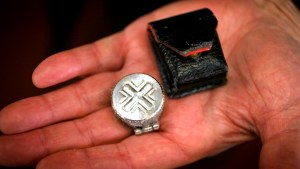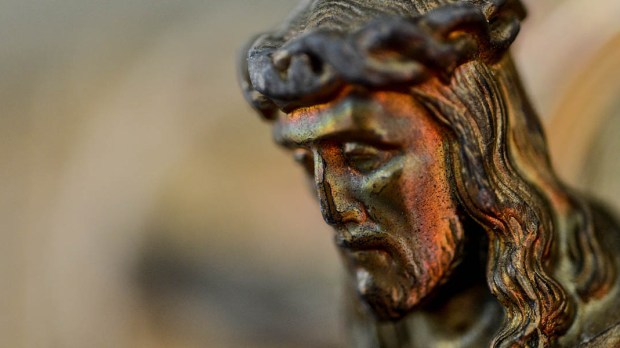When a person is homebound, bedridden, or suffering from a severe ailment, Catholics are taught to call the priest. Decades ago the sacrament reserved for the very ill or dying was known as Extreme Unction (last anointing) or more commonly “Last Rites.” Today we know it as the Anointing of the Sick, and it is not given exclusively to those who are on their deathbed. It is one of the seven sacraments and invokes God’s divine aid for those suffering in a physical way.
In days when people more often died at home, there developed the custom of having a “sick-call” crucifix on hand for emergency visits by a priest. This type of crucifix was hung on the wall of a person’s home (usually above the bed). The crucifix contained a hidden compartment, revealed by sliding the face of the cross downward. Within the compartment were two candles, a small bottle of holy water and sometimes a white cloth.
The purpose of the sick-call crucifix — they are still made today — is to facilitate the ritual connected to the Anointing of the Sick, making the bedside a sacred space for the sacrament. Interestingly, it used to be a popular wedding present, meant to be hung over the bed of a married couple, ready to be of used when a spouse was in need of an anointing. It reminded the couple of their commitment to be true to each other “in sickness and in health.”
Here is brief instruction on how to prepare for a home visit by a priest to celebrate the Anointing of the Sick.
Prepare a small table next to the bed
This can often be a nightstand or a collapsable table that is small and easy to move. The table will be there to hold all of the various elements of the ritual.
Place a white cloth on the table
It is appropriate to place a white cloth over the table, similar to the white cloth covers the altar at Mass. If the sick person is near death, or has requested to receive Holy Communion as part of the Anointing, the priest will bring a small container called a pyx with a consecrated Eucharistic host in it. The priest will place the pyx on the table and so the white cloth adds greater reverence and respect to the King of Kings who is truly present in the host. (This is also the case when an Extraordinary Minister of Holy Communion brings the Eucharist to a person who is hospitalized or homebound.)
Set up the crucifix on the table
A sick-call crucifix is constructed so that, when opened, the face of the crucifix can be set upright in a slot in the base. This creates a focal point of the sacrament, encouraging the sick person to unite their sufferings with Christ on the cross.
Place one candle on each side of the crucifix
The crucifix will also have two slots, one on either side. This is where the candles are to be placed and lit when the priest arrives. Again, this is to mimic the altar at Mass, reminding all present that Christ is truly present in the Eucharistic host that the priest brings with him.
Other (optional) items to have
The holy water bottle can be placed on the table as well, though often the priest will bring his own with him. This is used to bless the sick person. After the priest administers the anointing with the Oil of the Sick (which he will bring, from the parish’s store of oils consecrated at the Chrism Mass each year, in a container called a stock), he will need a white cloth or cotton ball to wipe his fingers. (Sock sick-call crucifixes include these items, or the priest may bring his own.) Another variation of the sick-call set has a small bell to be set on the table for use after confession, signaling that family members may return to the room.
The sick-call crucifix is a beautiful tradition, one that adds a greater solemnity for the occasion, reminding all in the room of God’s presence among them.

Read more:
What is the Apostolic Pardon?

